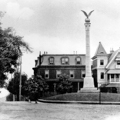This column was the first public monument ever erected in Wilmington and incorporates a fragment of one of America's most historic lost structures. In 1868, Latrobe's Bank of Pennsylvania, Philadelphia, was demolished to make way for the U.S. Appraisers' Stores Building. Delaware Civil War veteran Albert S. Nones suggested to U.S. Congressman Charles O'Neill of Philadelphia that its columns be made into war memorials to be designed by the architect Mullett. Congress passed a bill of authorization. Through Nones's leadership, the Soldiers and Sailors Monument Association, Delaware, successfully applied for one of the columns, which formed the basis for the state's only Civil War soldiers memorial. (Other Latrobe-column memorials survive at Adrian, Michigan, and Dayton, Ohio.) Lowe fashioned the globe and eagle (which grapples with the serpent of rebellion), cast at Pusey and Jones Company in Wilmington from donated cannon bronze. The monument was dedicated in May 1871 by General Oliver O. Howard of the Freedman's Bureau. Debts went unpaid, and the sheriff seized the monument for a time. Willam du Pont enclosed the plot with granite copings in 1893 as Monument Place. The landscaping is modern (1978, Edward Bachtle). The surrounding neighborhood has interesting houses of the 1870s–1880s era, although the childhood home of memoirist Henry Seidel Canby (The Age of Confidence, 1934) at 1212 Delaware Avenue was torn down for a 1920s-era apartment house.
You are here
Soldiers and Sailors Monument
1871, Alfred B. Mullett, incorporating a 1799–1801 column by Benjamin Henry Latrobe; Harry Lowe, sculptor. Delaware Ave. and Broom St.
If SAH Archipedia has been useful to you, please consider supporting it.
SAH Archipedia tells the story of the United States through its buildings, landscapes, and cities. This freely available resource empowers the public with authoritative knowledge that deepens their understanding and appreciation of the built environment. But the Society of Architectural Historians, which created SAH Archipedia with University of Virginia Press, needs your support to maintain the high-caliber research, writing, photography, cartography, editing, design, and programming that make SAH Archipedia a trusted online resource available to all who value the history of place, heritage tourism, and learning.





